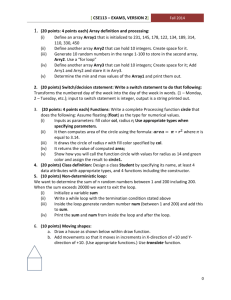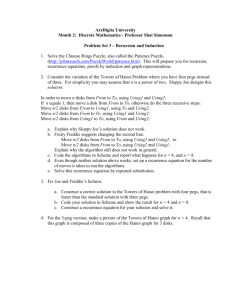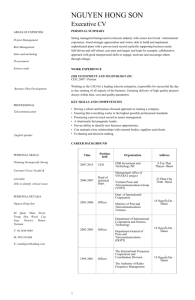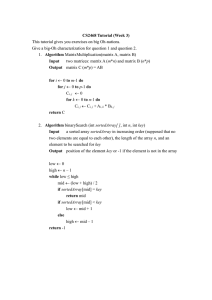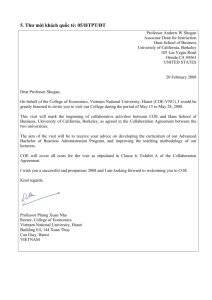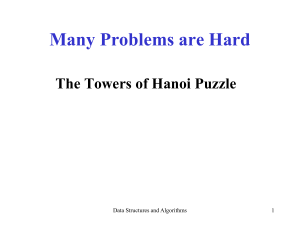Introduction to Computers and Programming Big-O
advertisement
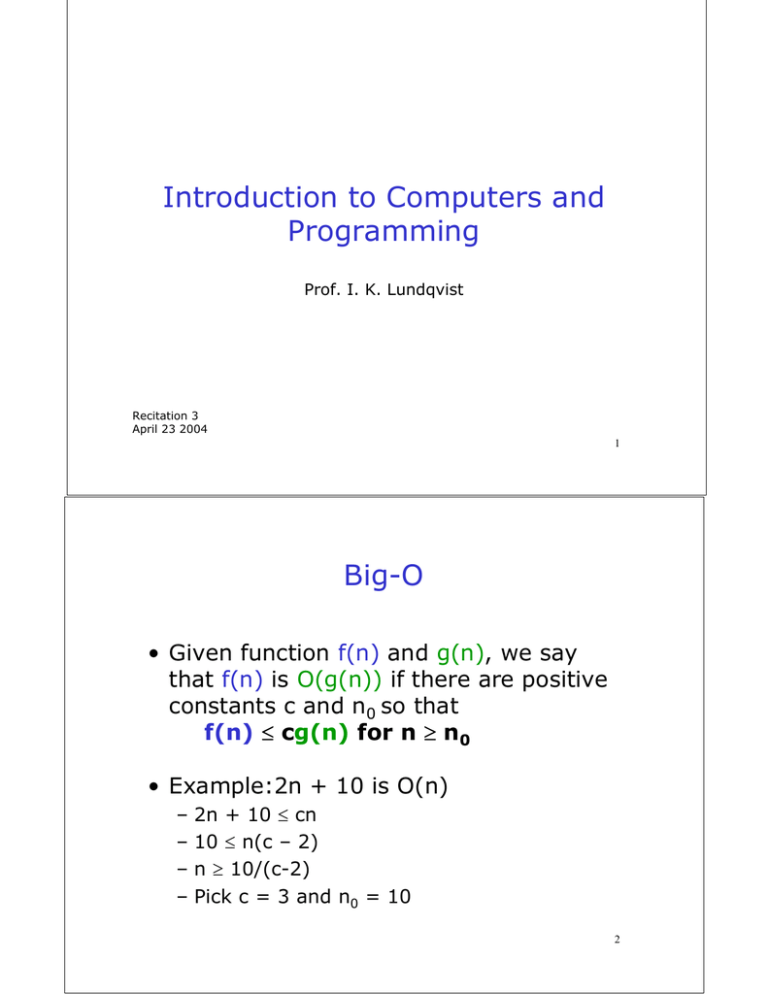
Introduction to Computers and Programming Prof. I. K. Lundqvist Recitation 3 April 23 2004 1 Big-O • Given function f(n) and g(n), we say that f(n) is O(g(n)) if there are positive constants c and n0 so that f(n) ≤ cg(n) for n ≥ n0 • Example:2n + 10 is O(n) – – – – 2n + 10 ≤ cn 10 ≤ n(c – 2) n ≥ 10/(c-2) Pick c = 3 and n0 = 10 2 Big-O • 4n – 2 is O(n) – Need a c > 0 and n0 ≥ 1 so that 4n-2 ≤ cn for n ≥ n0 true for c = 4 and n0 = 1 • 5n3 + 10n2 + 4n +2 is O(n3) – Need a c > 0 and n0 ≥ 1 so that 5n3+10n2+4n +2 ≤ cn3 for n ≥ n0 true for c = 21 and n0 = 1 • 2 log2n + 3 is O(log2 n) – Need a c > 0 and n0 ≥ 1 so that 2log2 n + 3 ≤ c log2 n for n ≥ n0 true for c = 5 and n0 = 2 4 Big-O • Given function f(n) and g(n), we say that f(n) is O(g(n)) if there are positive constants c and n0 so that f(n) ≤ cg(n) for n ≥ n0 g(n) grows more f(n) grows more g(n) and f(n) has same growth f(n) is O(g(n)) g(n) is O(f(n)) Yes No No Yes Yes Yes 5 Ex 1 type Int_Array is array (Integer range <>) of Integer; procedure Measure (A : Int_Array ) is Sum : Integer := 0; begin for I in A'range loop for J in A'range loop Sum := Sum + A(J); end loop; Inner loop Outer loop end loop; end Measure; 6 Statement Runs in X time Executes # of times Variable Sum is initialized Constant1 1 Array of size n is created Constant2 1 Variable I is created and initialized Constant3 1 I is tested against A’range (n) Constant4 n+1 Variable J is created and initialized Constant5 n J is tested against A’range (n) Constant6 n(n+1) Sum is incremented by A(J) Constant7 n2 J is incremented by 1 Constant8 n2 Constant9 n I is incremented by 1 7 BigO.adb Ex 2 type Int_Array is array (Integer range <>) of Integer; procedure Measure (A : Int_Array ) is Sum : Integer := 0; begin for I in A'range loop for J in 1 .. I loop –- only change to Ex 1 Sum := Sum + A(J); end loop; end loop; end Measure; 8 BigO2.adb CQ – Ex 2 Variable J is created and initialized Constant5 J is tested against I Constant6 Sum is incremented by A(J) Constant7 J is incremented by 1 Constant8 1. N, N*(N+1), N*N, N 2. N, N*(I+1), N*N, N*N 3. N, N*(I+1), N*I, N*I 4. I still don’t get it 9 Ex 3 type Int_Array is array (Integer range <>) of Integer; procedure Measure (A : Int_Array ) is Sum : Integer := 0; begin for I in A'range loop for J in 1 .. 4 loop Sum := Sum + A(I); end loop; -- only change to Ex 2 -- only change to Ex 2 end loop; end Measure; 10 BigO3.adb CQ – Ex 3 Variable J is created and initialized Constant5 J is tested against I Constant6 Sum is incremented by A(J) Constant7 J is incremented by 1 Constant8 1. N, N*(I+1), N*I, N*I 2. N, N*5, N*4, N*4 3. N, N*5, 4, 4 4. I still don’t get it 11 Ex 4 function Factorial (N : in Natural ) return Positive is begin if N = 0 then return 1; else return N * Factorial (N-1); end if; end Factorial; 12 CQ – Ex 4 How long time does executing the Factorial algorithm take? 1. O(n) 2. O(n2) 3. log n 4. 42 13 Divide and Conquer • It is an algorithmic design paradigm that contains the following steps – Divide: Break the problem into smaller sub-problems – Recur: Solve each of the sub-problems recursively – Conquer: Combine the solutions of each of the sub-problems to form the solution of the problem Represent the solution using a recurrence equation 14 Merge Sort • Divide: Split the array into into two subarrays A(p .. mid) and A(mid+1 .. r), where mid is (p + r)/2 • Conquer by recursively sorting the two subarrays A(p .. mid) and A(mid+1 .. r) • Combine by merging the two sorted subarrays A(p .. mid) and A(mid+1 .. r) to produce a single sorted subarray A(p .. r) 15 Merge • Input: Array A and indices p, mid, r such that – p ≤ mid < r – subarray A(p .. mid) is sorted and subarray A(mid+1 .. r) is sorted • Output: single sorted array A(p .. r) • T(n) = O(n), where n=r-p+1 = # of elements being merged 16 Merge Sort Analysis • The base case: when n =1, T(n)=O(1) • When n ≥ 2, time for merge sort steps: – Divide: Compute mid as the average of p, r ⇒cost = O(1) – Conquer: Solve 2 subproblems, each of size n/ 2 ⇒cost = 2T(n/2) – Combine: merge to an n element subarray ⇒ cost = O(n) T(n) = O(1) 2T(n/2) + O(n) + O(1) n=1 n>171 Solving Recurrences: Iteration c n =1 ⎧ ⎪ ⎛ n⎞ T (n) = ⎨aT ⎜ ⎟ + cn n > 1 ⎪⎩ ⎝ b ⎠ 18 • T(n) = aT(n/b) + cn a(aT(n/b/b) + cn/b) + cn a2T(n/b2) + cna/b + cn a2T(n/b2) + cn(a/b + 1) a2(aT(n/b2/b) + cn/b2) + cn(a/b + 1) a3T(n/b3) + cn(a2/b2) + cn(a/b + 1) a3T(n/b3) + cn(a2/b2 + a/b + 1) … akT(n/bk) + cn(ak-1/bk-1 + ak-2/bk-2 + … + a2/b2 + a/b + 1) 19 c n =1 ⎧ ⎪ T (n) = ⎨aT ⎛ n ⎞ + cn n > 1 ⎜ ⎟ ⎪⎩ ⎝ b ⎠ • So we have – T(n) = akT(n/bk) + cn(ak-1/bk-1 + ... + a2/b2 + a/b + 1) • For k = logb n – n = bk – T(n) = akT(1) + cn(ak-1/bk-1 + ... + a2/b2 + a/b + 1) = akc + cn(ak-1/bk-1 + ... + a2/b2 + a/b + 1) = cak + cn(ak-1/bk-1 + ... + a2/b2 + a/b + 1) = cnak /bk + cn(ak-1/bk-1 + ... + a2/b2 + a/b + 1) = cn(ak/bk + ... + a2/b2 + a/b + 1) 20 c n =1 ⎧ ⎪ ⎛n⎞ T (n) = ⎨aT ⎜ ⎟ + cn n > 1 ⎪⎩ ⎝ b ⎠ • So with k = logb n – T(n) = cn(ak/bk + ... + a2/b2 + a/b + 1) • What if a = b? – T(n) = cn(k + 1) = cn(logb n + 1) = O(n log n) T(n) = O(1) 2T(n/2) + O(n) + O(1) n=1 n>211 The Master Method • Given: a divide and conquer algorithm – An algorithm that divides the problem of size n into a subproblems, each of size n/b – Let the cost of each stage (i.e., the work to divide the problem + combine solved subproblems) be described by the function f(n) – The master method provides a simple “cookbook” solution 22 Simplified Master Method • T(n) = aT(n/b) + cnk, where a,c > 0 and b > 1 ( ) O(n log n ) O(n ) O n logb a T(n) = k b k a > bk a = bk a < bk 23 The Towers of Hanoi • Goal: Move stack of rings to another peg – May only move 1 ring at a time – May never have larger ring on top of smaller ring 24 The Towers of Hanoi For simplicity, suppose there were just 3 disks A B C Since we can only move one disk at a time, we move the top disk from A to B. The Towers of Hanoi For simplicity, suppose there were just 3 disks A B C We then move the top disk from A to C. The Towers of Hanoi For simplicity, suppose there were just 3 disks A B C We then move the top disk from B to C. The Towers of Hanoi For simplicity, suppose there were just 3 disks A B C We then move the top disk from A to B. The Towers of Hanoi For simplicity, suppose there were just 3 disks A B C We then move the top disk from C to A. The Towers of Hanoi For simplicity, suppose there were just 3 disks A B C We then move the top disk from C to B. The Towers of Hanoi For simplicity, suppose there were just 3 disks A B C We then move the top disk from A to B. The Towers of Hanoi For simplicity, suppose there were just 3 disks A B C and we’re done! The problem gets more difficult as the number of disks increases... The Towers of Hanoi • • • • 1 2 3 4 ring rings rings rings Æ Æ Æ Æ 1 operation 3 operations 7 operations 15 operations Cost: 2N-1 = O(2N) • 64 rings Æ 264 operations 33 Towers of Hanoi • hanoi(from,to,other,number) -- move the top number disks -- from needle from to needle to if number=1 then move the top disk from needle from to needle to else hanoi(from,other,to, number-1) hanoi(from,to,other, 1) hanoi(other,to, from, number-1) end 34 Some math that is good to know • • • • • • • • • logb(xy) = logbx + logby logb(x/y) = logbx – logby logbxa = alogbx logba = logxa/logxb a(b+c) = abac abc = (ab)c ab/ac = a(b-c) b = alogab bc = aclogab 35


